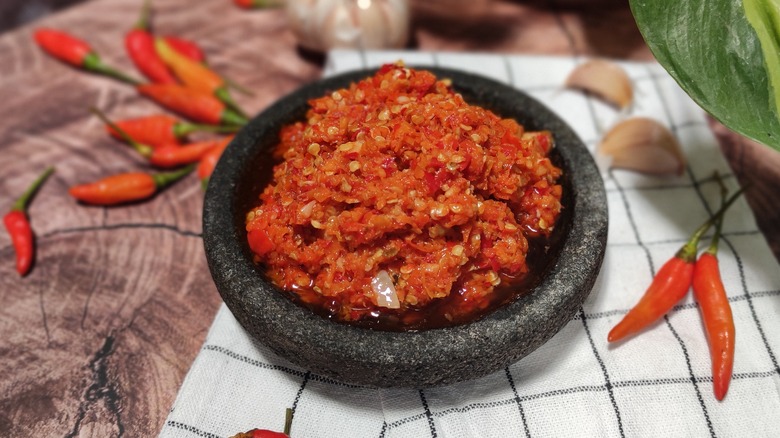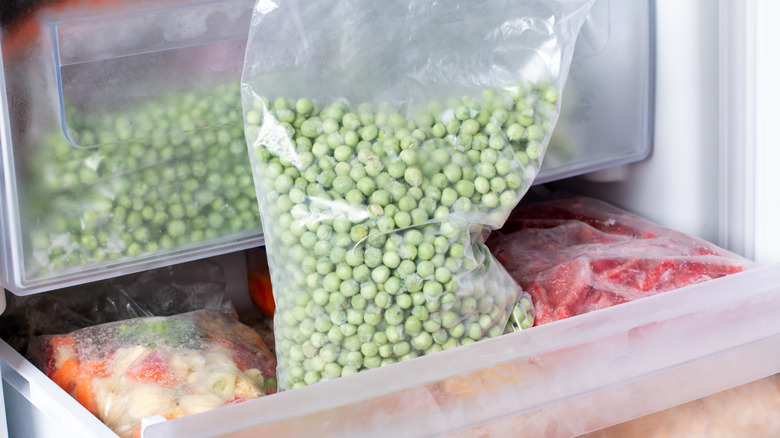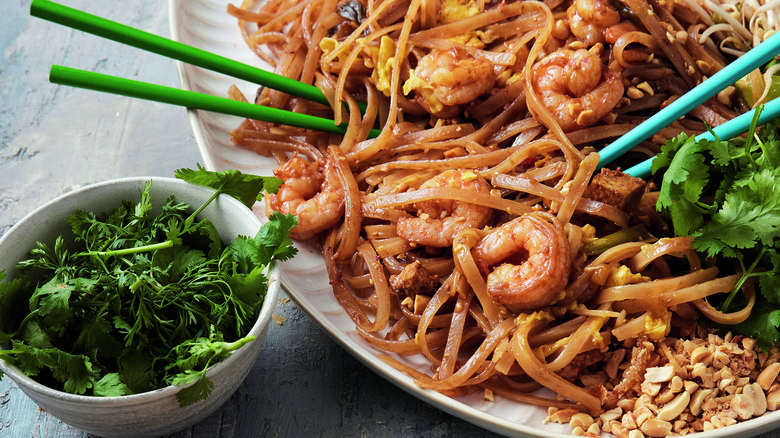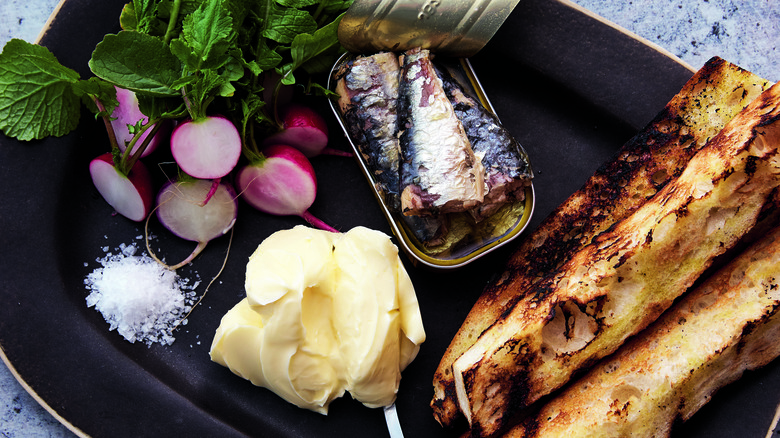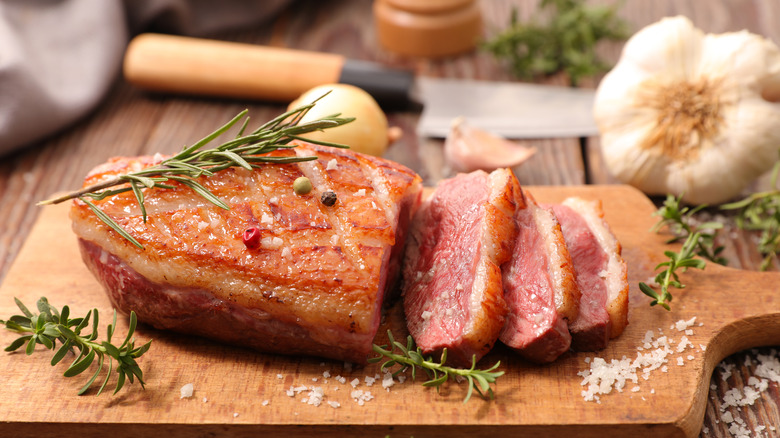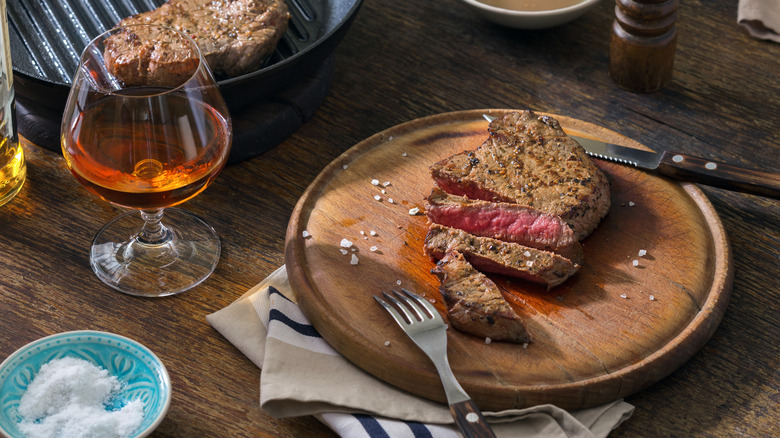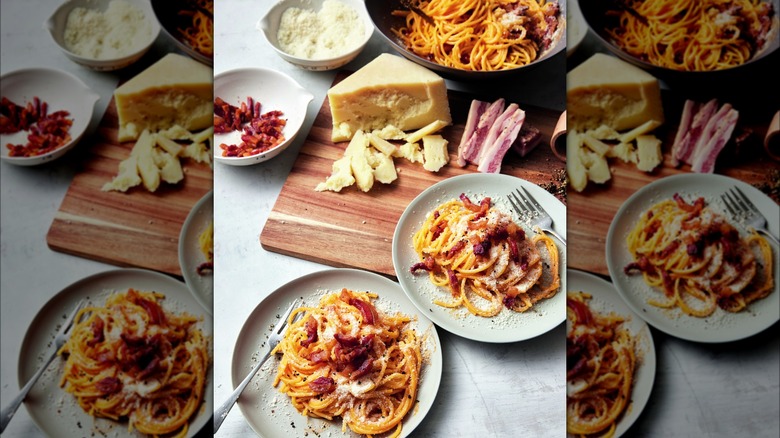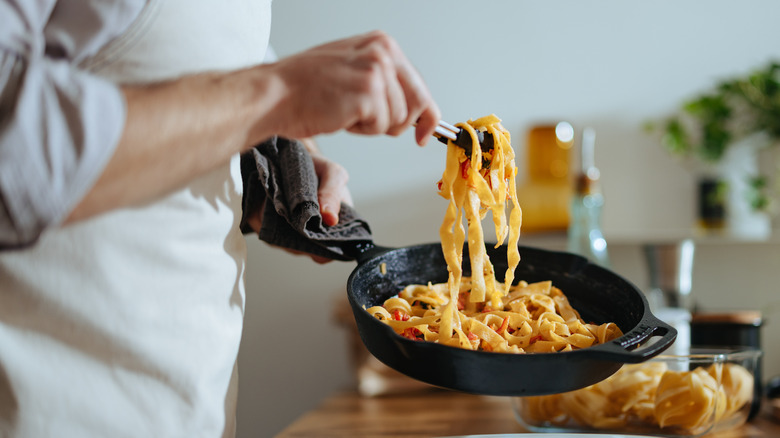Rocco DiSpirito Tells Us The Secret To Preparing 30-Minute Meals That Still Impress - Exclusive Interview
Chef Rocco DiSpirito has ventured in many directions throughout his career, from his various appearances on reality food television to restaurants and a multitude of cookbooks. With a focus on Italian cuisine, healthy eating, and quick dinner fixes, the chef has gained fans among enthusiastic home cooks. DiSpirito continues to pursue his culinary interests, bringing his latest cookbook "Everyday Delicious: 30 Minute(ish) Home-Cooked Meals Made Simple" to the table. The book provides an array of recipes, many of which can be prepared in around half an hour without compromising on flavor.
We spoke with Rocco DiSpirito to dive deeper into the making of his new cookbook and the top ingredients he can't live without. Whether you're planning a weeknight meal or preparing for a dinner party, he has plenty of tips to keep the prep time low and the flavor high. With a range of cuisines to satisfy all tastes, DiSpirito turns cooking at home into an entertaining task.
Condiments are king
You stress the importance of condiments in your new book "Everyday Delicious." What underrated condiment do you find most versatile when you want to whip up a quick 30-minute meal?
That's a great question, I think all of them are underrated. I call them flavor detonators and a little bit of a chef's trick. There are a world of condiments/prepared foods/sauces now that didn't exist 10 years ago that really just do so much to a dish. You could be making scrambled eggs, and then if you add sambal oelek, which is basically garlic and chili, you've got a whole new dish that inspires you to take it into a whole new direction. Sambal oelek for me is an incredible condiment that's actually pretty good for you. It's got garlic, it's got chili, it's got very little sugar ... it's so dynamic in terms of flavor. I mean, it feels like you've added a thousand ingredients to your dish, but it's just one. So that's one of my favorites. I also like dark soy.
Compared with light soy, is it just less diluted or is it a different extraction process?
It's seasoned, so they add some sugar and they add some stuff to it to make it a little bit more, you know delicious, I guess is the word. The amount of soy products in the Asian lexicon is pretty intense, there's quite a lot. And I think we're just scratching the surface, really, when we look at the ones that we're using ...
Kombu powder is another one that is mind-blowing ... It's made with kombu and bonito flakes, and that added to basically any dish will turn it into either an Asian delicacy or a very complex-tasting, incredible dish.
All the fermented chili sauces, the fermented black bean sauces, garlic sauces, chili crunch, all of those are incredible flavor detonators. Harissa is another one ... think about all the spices in harissa. These are essentially compound spices or sauces. They do the work of three prep cooks.
Tamarind is another one that blows my mind. Tamarind is so complex, sweet, sour, bitter, textured, colorful, and it's crazy. Furikake is another one ... it's basically crushed nori powder or nori paper and sesame seeds, and then 15 other possibilities, like anything from dried shrimp to dried egg, little bits of squid, all kinds of things. And that's another great example of how one addition changes texture, color, visuals, flavor, and mouthfeel.
Yeah, absolutely, that is very multi-layered. So you can go in so many ways with the taste.
Shaoxing cooking wine, which I like to call the cooking sherry of the Asian or the Chinese world ... it's an oxidized wine — a little bit of that goes a long way. Bull-Dog sauce, which is typically a fruit-based sauce used for tonkatsu, is another incredible flavor detonator compound sauce. If you have 10 of these in your kitchen and you use them liberally, you're going to go from like level three to level seven instantly.
Quick flavorful tips to elevate your meal
Do you have any two or three-ingredient recipes using one of those condiments that you make if you want a quick meal or a snack?
I mean, think about boiled eggs and mayo. Now add either harissa or gochujang and furikake or dashi powder or even yellow mustard. Yellow mustard has about 15 spices in it including turmeric, cloves, and all kinds of stuff ...
I keep these around all the time, I use them liberally. Even though this isn't a health-focused book, I'm still very focused on health. And yellow mustard, for example, has basically no sugar, lots of wonderful ingredients, nothing to worry about. And again, just gigantic flavor pop.
Not making those from scratch saves time when you want to layer flavors that would have taken hours otherwise. Aside from those time savers, are there other things you find that home cooks don't take advantage of?
The bouillon powders that are out there now are really good. I used to poo-poo that stuff, but now cooking at home, I really understand how you're always grasping for more flavor, more texture, more love. What I found is that a lot of home cooks, like my mom and other people's moms, and in the Asian kitchen, they're using MSG a lot. A lot of times it's bouillon powder, it's chicken powder, it's got a million brand names, but most of the time you're talking about basically some sort of concentrated poultry flavor, which almost always has MSG. Then another way to get the MSG flavor, glutamate flavor, is Parmigiano Reggiano, probably one of the greatest condiments ever invented.
Focusing on the details that count
Are there techniques, components, or ingredients that you definitely want to take the extra time to make?
Yes. High-heat cooking using the full surface of your cooking utensil. Large pans, high heat, doing the proper heating method, which is turn on the stove, put the dry clean pan on the stove, let it get hot, add your fat, allow that to get hot. Once that's shimmering, then take your dry protein — whether it's shrimp, chicken, beef, whatever it is you're cooking — season it, dry it, pat it dry. That process that pro cooks do all the time, is something home cooks really need to emulate, because it does make a huge difference between basically a steamed piece of protein and a properly sauteed caramelized piece of protein. It's literally night and day.
You emphasize the importance of mise en place and having all your ingredients ready to toss in. Do you have other tips for streamlining meal prep at home?
The mise en place is definitely important. Obviously, you want to be ready to cook once you start cooking. There are other things that are not so important, like peeling and cooking and cleaning all your own vegetables. You can buy a lot of vegetables now that are either frozen or fresh that are already prepared. Frozen peas are one of my favorites, as is cut salad. I know, it's crazy, but I happen to think it's terrific. I think it saves a lot of time and energy and space.
The slow-cooking world is something people really need to take a look at. Don't sleep on slow cooking, whether it's a Crock-Pot or the Control Freak from Breville or an Instant Pot or just a good old-fashioned Le Creuset pot with a lid. Slow cooking is still a beast when it comes to cooking what I would call second and third cuts of meat and tenderizing food and developing tremendous flavor.
Noodles for the win
So two kinds of instant noodles that I think are great — not ones that are designed to be instant, but ones that just happen to be instant — rice sticks, basically what we use for Thai food and lots of Asian food. Any kind of rice noodle will cook instantly the minute it hits water.
And then I use a lot of kelp noodles because sometimes I like to control carbs. They cook in seconds, they taste just like noodles made out of seaweed, and it really saves a lot of time. So if you like to eat pasta and you don't like the work and you don't like the nutrition profile, the kelp noodles are a great option. I used to use miracle noodles which are made from the konjac plant, which I still like a lot. But I find most people can't stand them, so the kelp noodles don't have any of the weird smell or the water they're packed in.
How do you cook rice noodles? Do you just pour boiling water on them?
Whatever you're making, you can throw them in. If you want a little bit of an easier transition from a dry stick to a cooked noodle, soak them in water first and then you don't even need water in the pot. If you're making pad Thai, for example, they don't boil the noodles. They soak them in cold water. They leave them in a bucket soaked all day, all night and then they just throw them in hot water.
Cooking and serving fish in numerous ways
Your salmon recipes mostly cook at high heat only for a few minutes, which is a contrast to many recipes that call for low heat and more time in the oven. Why do you prefer this method?
Salmon needs to brown, salmon needs caramelization. Because salmon is so high fat, usually the carryover cooking is tremendous. Salmon can go from basically raw to well done if you leave it sitting on the counter for 15 minutes. It'll just keep cooking until it's sawdust basically, so you only really need to sear it and then just let it sit.
You have a simple tinned sardines on toast recipe in your new book. Are there other types of tinned fish you like to keep on hand?
Yes, I keep a lot of tinned fish on hand. In terms of nutrition, they are just an absolute macro nutritional bomb. They have the right protein, the right kinds of fat, all the nutrition that you're looking for, the micros that you're looking for in terms of minerals out of anything that comes out of the ocean. They taste, obviously, ridiculously delicious. And usually one can is more than enough, it's about four ounces.
I like to eat two if I'm really hungry, and I throw them on a bed of romaine and it almost needs nothing, but lemon juice and mustard are a great help. Radishes too. I think the butter and bread route is great like I outlined in the book. I know a lot of people don't like to mess with canned fish because of the smell or whatever. I don't want to highlight that part because I think it smells amazing. My cats certainly love how it smells. And my dogs too, by the way. If you're looking for something super easy and delicious and really trendy right now, that's a great one.
How to host with minimal stress
You present a Thanksgiving dinner with all the fixings in your new cookbook, outlining all the different steps to get the meal on the table. What tips can you share for managing all the dishes without ruining anything?
Cook them ahead a day before, two days before, and then just reheat them the day of. And by reheat them, I mean leave them out, on the patio table if you have to, and just let them come to room temperature. If they're room temp, they only need 15 minutes in the oven. So if you're making stuffing or vegetable sides or even pie or fruit — any of that stuff can be cooked ahead and then reheated. Any sort of noodle dish, or squash side dish, or mushroom side dish, even Brussels sprouts, can all be cooked and reheated.
Serve some of it raw. Brussels sprouts are great shaved and raw in a salad. There are quite a few things that you can serve raw. Many of the vegetables that we spend a lot of time cooking can be served raw. Artichokes are another great example.
Choosing the container is important. So this is when I think it's a good time to invest in aluminum catering pans. These things are life savers. If you get the 1- or 2-inch high ones with a cover, you can stack them. You can put them in your oven and stack 10 of them on top of each other, and just let them heat in the back of the oven while you're cooking other things. I like to take out all the shelves in the oven and then just basically take control of the space ...
Once you've heated up your food, put it in the microwave and just store it there. You don't need to use the microwave, but the microwave is a great storage area. It keeps it away from kids and pets and it's closed.
Taking a chance on duck
You have a great duck recipe in your cookbook, and you mention the poultry's forgiving nature. What are some tips for people who have never cooked duck to make it at home?
Cooking [duck breast] in a pan skin-side down is a great method, low heat to high heat. We're talking maybe 20 minutes total, sometimes five, 10 minutes if you pound it. And then there's always duck confit available. I see duck confit precooked everywhere now, and often it's from D'Artagnan, which is one of the great brands that originated with a wonderful French person who brought all that creativity, Ariane [Daguin]. Cooked duck confit is like instant deliciousness. All you have to do is heat it up or barely heat it up, it's ready to go. The whole duck could be a little bit of a pain and cause some anxiety unless you have time and you're really feeling brave.
I agree, duck confit is definitely one of my favorite super speedy dinners that just tastes delicious.
It's great with a salad, a little bit of frisee, which is now 10 bucks a piece ... I use escarole now, which is very similar. Or the chicories or any of those mustardy ones. Duck confit is very sweet; it's very fatty and rich. So you need something that has a crispy, great textural contrast and also has bitterness. So anything in the mustard world, Belgian endive. Perfect. Escarole. Perfect. Any mustard green. Any chicory. Trevisano. Radicchio ... And then I like a fried egg on top. And then if you want to get really wild, a little bit of the sambal and some fried shallots and garlic you can buy at Asian stores.
The beef pairing you need to try
You have a few beef recipes in the cookbook that feature cognac, which is a less familiar pairing. What do you like about combining the two?
Cognac has a very specific flavor and also a very deep, rich flavor. And it's obviously unique. It comes from one part of France, it's always made in the same way, it's aged ... I happen to think that beef and cognac are just natural flavor mates. I add dates to that dish too, and I think those three things together are just superb, like the holy trinity of braise flavors. In a long, slow cook where the cognac and the dates both can flavor the liquid as well as the beef, obviously, they're terrific.
But red wine, even white wine, red Port are all great. I've seen lots of those spirits and oxidized wines, fortified wines, like Port, Madeira, all work well. They're obviously flavored with grapes, mostly, but they also are fortified, and they have a deep, rich flavor that ultimately comes from the earth that just works so well with beef.
The perfect carbonara
You have a very egg-forward carbonara recipe in the book with a dozen egg yolks. Why do you like to use so many?
Well, I think there's a lot of debate on carbonara, so I wanted to solve a few rumors and riddles. People like to use whole eggs — it's very forgiving. There's water in the egg whites that helps make the process a little more gentle on the cook, because egg yolks can dry very quickly. But if you have the whites, it slows the process down because of the water content.
And I don't like the flavor you get with that, either. I really like the concentrated yolk flavor. I think that's the flavor that everybody likes with carbonara. It's the reason people think there's cream in carbonara, right? It's what happens when you mix the yolk, which obviously is protein and fat and very little moisture, with the pecorino cheese. People don't realize that egg yolk is a sauce. It's already a type of sauce called a gel. And when you add the whites, you kind of interfere with that texture. So I wanted to get rid of the whites and then add enough yolks back to give people a lot of comfort when they're mixing this. If you take it off the stove and mix it in a bowl, like I recommend, it should work perfectly. If you have to put it back on the stove because you miscalculated the heat, there's still plenty of raw egg yolk to give you a little more runway.
Pasta cooking traditions
You have a couple of pasta dishes where you refer to your mom and grandmother's recipes. Aside from the flavor profile of the sauces, did you learn any tips from them about cooking pasta to the optimal doneness?
So yes and no. My father liked his pasta overcooked, the rest of my family liked pasta al dente. So there was always a struggle in the kitchen, and my mom would have to take some pasta out ahead of time and then leave some in the pot. And then I also developed my own preferences as I learned to cook and continue to cook thousands of pastas in a restaurant setting for much of my life.
And there's no question that removing the pasta very al dente and allowing it to marry with whatever sauce you're making is the way to go. When we say marriage, we're talking about the sauce and the molecules of starch absorbing the sauce, becoming one new thing in the pan or in a bowl. And that's, I think, the difference between really good pasta that you've had out and just basic pasta. What you don't want to do is make pasta and then put a sauce on top of it and serve it right away.
There's always a little extra liquid in your sauce. Instead of draining it or just living with it, you allow the pasta to absorb it. Pasta starch molecules have plenty of room for more water. Whatever's non-water, whatever solids you have and fat you have, doesn't get absorbed, it just becomes a coating. And that's a mixture of marrying the pasta and the sauce with enough time, enough mixing, enough tossing, whether in a bowl or in a pan.
But yes, I think whatever the manufacturer says for cooking time ... shave off two minutes, always, and then add it to the sauce and let it live in that sauce those extra two minutes. I do it much earlier, by the way, but I know most home cooks are going to think I'm crazy.
What do you have planned next?
I just shot a bunch of shows for Food Network. I'm working on the next book, which I think is going to be similar, but maybe a little more of my health focus worked back in. I hadn't done a "conventional" cookbook in a long time, so I wanted to do that. Now that I feel comfortable with it again, I'd like to work some health elements back into it. Not too much, but just enough so that people feel like they're doing something good for themselves.
And then I'm working on a pop-up for the summer and some healthy products like the bread and the protein powders that I've been working on for a while, I'm still making those.
Purchase a copy of "Everyday Delicious: 30 Minute(ish) Home-Cooked Meals Made Simple" by Rocco DiSpirito from your preferred book retailer.

